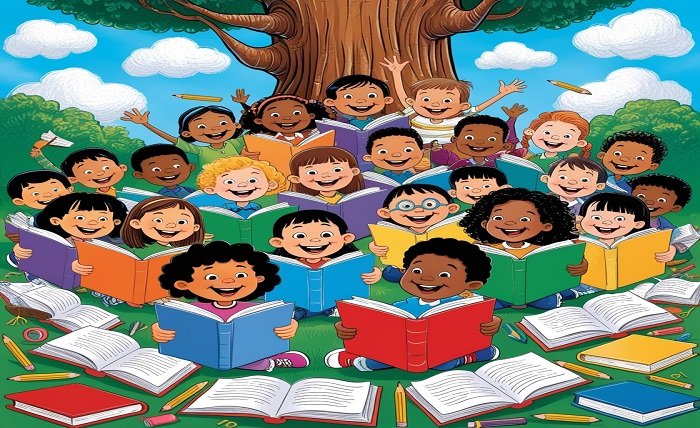This blog article will explore the world of education cartoon, including their importance, advantages, well-known applications, and effective ways for teachers to include them into their courses. We will also look at how educational cartoons are used in a variety of subjects, such as science, history, and language study, demonstrating that these cartoons are effective teaching resources in addition to being entertaining.
What Are Education Cartoons?
Fundamentally, an education cartoon is a kind of animated or illustrated material intended to both entertain and educate. These cartoons are especially designed to improve comprehension, make difficult concepts easier to understand, and help people remember more information. To make subjects more interesting, education cartoons frequently include comedy, exaggerated characters, and colorful imagery. Whether in the form of comic strips or little animated films, they employ narrative and imagery to present instructional ideas in a fun and easy-to-understand manner.
The Objective of Cartoons for Education
Making education accessible is the main goal of educational cartoons. education cartoons can address topics that may appear dull or difficult in a more approachable and pleasurable manner by utilizing comedy and inventiveness. These cartoons make subjects like physics, math, language arts, and history come to life, capturing the attention of kids who might otherwise find it difficult to learn through conventional means.
Cartoons’ Educational Benefits
Both teachers and students can benefit greatly from educational cartoons. These advantages go beyond simple amusement; they also offer educational benefits that might enhance learning results. The following explains why educational cartoons are becoming more and more common in classrooms worldwide:
Improved Retention
education cartoons are a great approach to apply the well-known visual aid effect of improving memory retention. Students are more likely to remember key topics later on if comedy and endearing personalities are linked to them.
Bringing Up Tough Subjects
Many students find some courses, like grammar, physics, and mathematics, to be difficult or dull. education cartoons simplify these difficult subjects into manageable, eye-catching chunks.
The Development of Educational Cartoons
From straightforward comic strips in textbooks to complex animated films utilized in classrooms and online learning environments, the usage of cartoons in education has changed over time. Cartoons were mostly intended to entertain children in the past, but they are now used by people of all ages and intellectual levels.
Initial Steps
Comic strips from the early 20th century served as the inspiration for education cartoon. Newspapers and textbooks frequently used these strips to make things more interesting and approachable.
Animated Cartoons’ Ascent
The popularity of education cartoon grew with the introduction of television and then the internet. The way educators felt about using cartoons in the classroom was completely changed by shows like Schoolhouse Rock and Sesame Street.
Well-known Cartoons for Education
A number of education cartoon have gained notoriety for their capacity to amuse audiences while imparting important lessons. Let’s examine a few of the most well-known and prosperous instances:
Sesame Street
For more than 50 years, Sesame Street, one of the most recognizable educational television programs, has taught kids everything from the alphabet to social-emotional skills. For generations of kids, learning has been enjoyable thanks to its endearing characters, such Big Bird and Elmo. The program helps children learn important skills using puppetry, animation, and upbeat music.
How Educational Cartoons Can Improve Classroom Instruction
education cartoons may be an effective tool for teachers in the classroom as well as a fantastic resource for individual learning. Teachers can use cartoons to improve learning in the following ways:
Dissecting Complicated Ideas
Cartoons can be used by educators to simplify and make difficult subjects easier to understand. For instance, a cartoon might illustrate the water cycle by showing how water evaporates, condenses, and falls as precipitation through the use of amusing characters. Compared to a dry textbook description, this visual aid aids pupils in understanding the process.
Promoting Intense Engagement
By asking children to solve issues, answer questions, or share what they’ve learned, education cartoon can motivate students to actively engage with the content. Teachers can encourage critical thinking and involvement by, for instance, pausing an instructional video halfway through and asking students to guess what will happen next.
Conclusion
In today’s educational environment, educational cartoons are an effective tool that make difficult subjects enjoyable, interesting, and memorable for pupils. Cartoons may transform learning from a tedious task into an exciting journey by fusing humor, images, and narrative. education cartoon will becoming more and more influential in determining the direction of education as we continue to adopt innovative teaching strategies and new technologies.
FAQ
Are children the only audience for educational cartoons?
No, educational cartoons can be made for adults as well as pupils of all ages. education cartoon can be used to teach difficult subjects to older students in an entertaining and captivating fashion, even though they are typically used for younger pupils.
Can language learning be aided by educational cartoons?
Of course! education cartoon are an excellent way to learn a language. They can aid kids in learning new words, enhancing their listening skills, and comprehending grammar in context.
How can educational cartoons be used in the classroom?
To introduce or reinforce lessons, you can employ cartoon-based activities, educational movies, or animations. Students can also be involved in the learning process by using interactive cartoon websites and applications.

